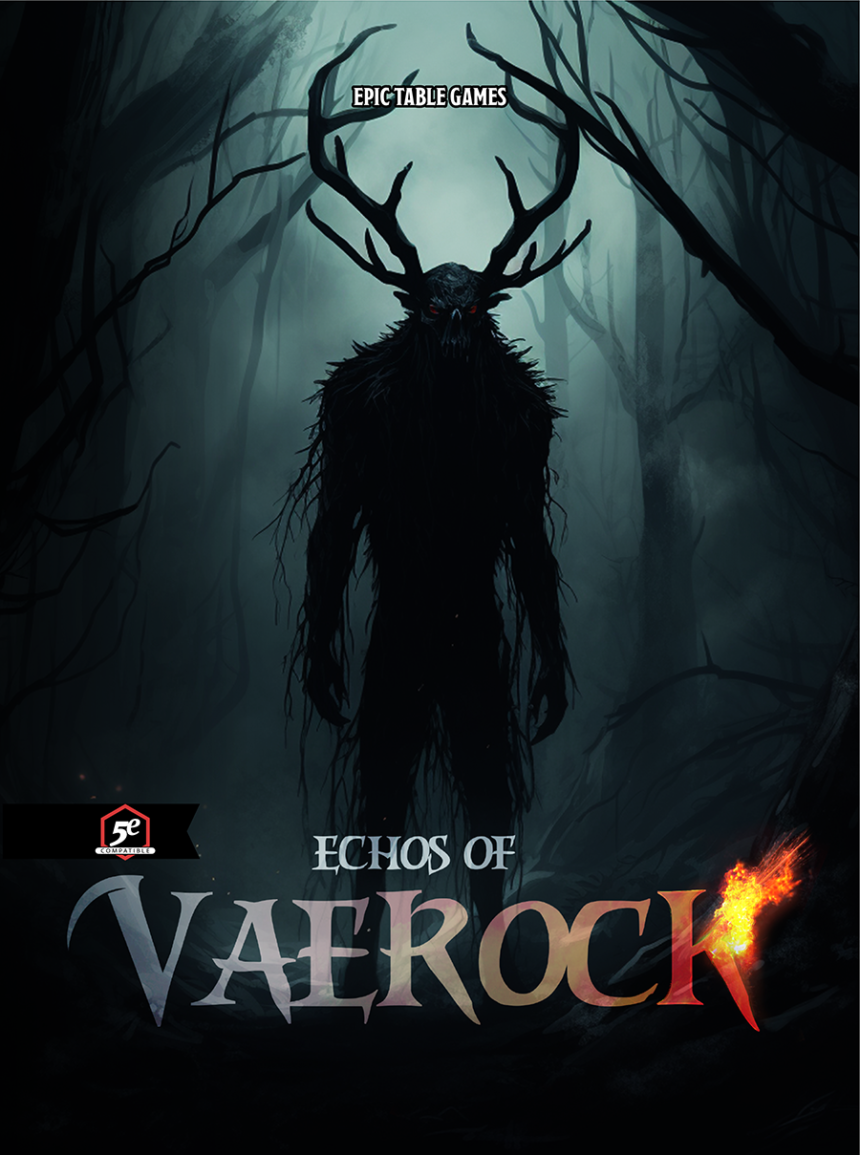Welcome back to the Epic Table, everyone! Once again, my best-laid plans of what to write about this week have been derailed by a piece of absolutely bizarre RPG news.
A little over a week ago, author Doug Strain unleashed The Book of Vile Math on the Dungeon Masters Guild. This appears to be Strain’s first supplement, with his other published works being adventure adaptations of several classic novels such as Heart of Darkness or Moby Dick. The book is designed for 5th Edition D&D play, but its contents can be very easily adapted to any other system.
They’re just, you know, totally deranged.
After reading through this book, I’m not sure who it’s for. I’m not sure it’s for anyone. I’m not sure it’s not some kind of meme or cosmic joke being played on the RPG community. I’m not sure who, apart from Doug Strain apparently, would ever willingly add these things to a gaming table, and I have no idea why it’s formatted in the way that it is. I have very rarely come away with more questions about a gaming supplement than this one. I therefore invite you to join me on my journey through The Book of Vile Math.
Initial Impressions
The BoVM weighs in as a 50-page PDF, presented using the standard D&D formatting seen all over the DMs Guild. Happily, a simple txt version is also available. I don’t recommend this version–several of the puzzles listed are almost impossible to understand (at least for me) without illustrations–but it’s always very nice when authors make these alternatives available to save on ink when printing. That’s a real consideration with this book: between the DM Guild formatting and the dozens of illustrations scattered throughout, this PDF is a real cartridge killer.
And my oh my, there are so many illustrations. In point of fact, this is a book that could probably do with fewer illustrations. Frequently, there are so many on the page that the text is practically crowded off it. It also doesn’t help that most of the images used are extremely low-resolution and appear very, very pixelated. While many of these images are necessary to understanding the puzzles within, as mentioned above, even more are simply window-dressing for the theme of the book. These could probably be done without.
Ultimately, the book’s layout comes across as extremely dense and crowded. It would be far easier to process some of the suggestions being made if page breaks were more liberally used, along with line spacing and perhaps a larger font size.
Midway On Our Lives’ Journey
Still, one way the slightly cramped feeling does come across is in the theming. The Book of Vile Math, as might be expected from its name, is presented as a Dante-like delve into the nine infernal circles of a… math-hell, basically. I’m not making that up: “This tome traces the path of the great wizard Dante Alighiebria through the circles of mathematical hell,” warns the introductory quote (purportedly from Mordenkainen). I cannot do any better than quote the name for each chapter (or “Circle”) as listed on the introductory page:
- 1st Circle: Limbo
- 2nd Circle Isomorpheus
- 3rd Circle Asmodus Ponens
- 4th Circle Vectorna
- 5th Circle Lucypher
- 6th Circle Bathomatter
- 7th Circle Orcalculus
- 8th Circle Baalzgebra
- 9th Circle Primeval Demonstras
I assure you, I am not making this up.
Poems–or rather, fragments of a longer, single poem–are scattered throughout the work as well, narrating the journey of our friend Dante the wizard through math-hell. In this, Dante is guided by Euclid (instead of Virgil, the classical choice). A number of the above-mentioned chapter names are also encountered as demons (devils?), with brief blurbs about their general attitude or outlook. These seem to fade away by the end, though, and are mostly present in the initial chapters.
I understand the desire to give the book a theme beyond just “here are some puzzles to put in your D&D campaign,” but ultimately I’m not sure this theming serves the BoVM in the end. Very few of the actual puzzles themselves are linked to the Dante-esque theme of the book, which ultimately makes the two sides of it feel very disconnected from each other.
Vile, Vile Math
At this point, you might be wondering: this is a book of puzzles. What are the puzzles actually about?
Math. Vile math. The title gets it spot on.
In the past, I have found that the puzzles which have been most effective for my adventuring parties are those that share many similarities with those designed for three-year-olds. Generally speaking, riddles or complex challenges are not their forte. Many of the puzzles I’ve seen in adventuring books over the years seem to have roughly the same level of complexity, with the underlying thought process seemingly being that we shouldn’t have to rack our brains too hard for an answer before moving on.
Just to give you an idea of what this book is like, the introduction includes some handy riddles you can toss into your dungeon at any time. Here’s one of them:
Intricate beauty within a complex realm. Infinitely smooth, my twists overwhelm. Square me and
add me, forever again. My patterns repeat, I stay in my bin.
The answer? “The Mandelbrot Set, a continuous but endlessly complex fractal created by iteratively applying x ⇒ x + c.” Obviously.
Yeah. It’s gonna be a bumpy ride.
The very first puzzle described in the first chapter is the classic “jump from tile to tile to form the phrase” as seen in Indiana Jones and the Last Crusade, among many, many others. Except this time, it’s not the name of the Almighty–it’s the digits of π! Of course, if you feel like mixing it up, you can use the digits of e instead! The clue for the latter, of course, is “The most common mathematical number in the dictionary.” And here you thought the cryptography references weren’t happening until Circle 5!
That’s a medium-difficulty puzzle, though. The first easy one–or at least “Easy-Medium”–requires the party to figure out that “4/1 – 4/3 + 4/5 – 4/7 + 4/9 – 4/11 + 4/13 – 4/15 + …” refers to a circle-shaped object since that series of fractions totals to π. Alternatively, the book suggests, a semi-circle could be used, since π is half a circle’s circumference. This did not even make sense to me until I remembered that π is, of course, equal to 180 degrees when representing radians.
Don’t even ask about the hard puzzles. Or the one “very hard” one I found, which appears to be some kind of computer science problem I am nowhere near mathematically qualified to attempt.
This is just the first chapter, though–many other puzzles await! There are all kinds from cryptography to physics. There’s even one involving the party finding the correct angle to fire a cannon at, given a known muzzle velocity and distance. (“Lucky for them,” the book helpfully supplies, “these cannonballs are known to magically ignore air resistance.”)
There’s also one monster and a handful of magic items scattered throughout, but they’re not exactly intuitive to use. The monster, a Tenured Math Dragon, features a legendary action that “only allows prime numbers of damage to pass through.” There’s also the Cube of Elemental Alchemy:
When activated, the cube creates a 4-inch cube of the element specified by the quantum numbers of its highest electron specified by n (energy), l (angular), m_l (magnetic), and m_s (spin) [as defined by the aufbau procedure, where positive numbers are considered higher energy].
The aufbau procedure. Naturally.
I have… no idea whose campaign this is for. I don’t even want to picture what kind of campaign would use multiple entries from this book. Most of these puzzles are options that I don’t think dedicated math instructors would find fun and may actually require the use of a graphing calculator. There’s no About the Author here, which is the most glaring omission in the entire book because I feel that one would possibly give us some meager insight into the burning question of WHY.
If you were wondering, the poems also aren’t great.
Should You Get This?
This book is free.
On the one hand, reading it has definitely inspired new ways to torture players.
On the other, downloading it may actually encourage the author to do this again.
Choose wisely.
And Now, A Small Plug
I’ve recently released MYTHWALKERS, a collection of playbooks for Apocalypse World 2nd Edition on my itch.io page. It features five playbooks that play with stories, language, and communication. Get it on itch here!
Correction: An earlier version of this article referred to the author of the Book of Vile Math as both Doug Strain and Doug Stein. The correct spelling is Doug Strain. Apologies to Mr. Strain!
The contents of this post are © 2024 H. Tucker Cobey. All rights reserved.





